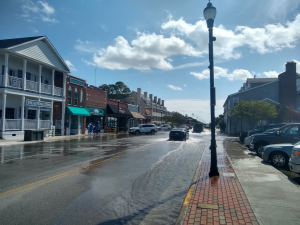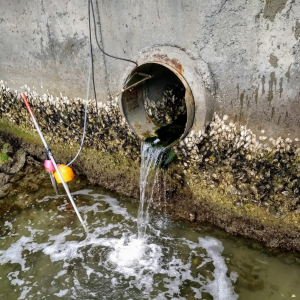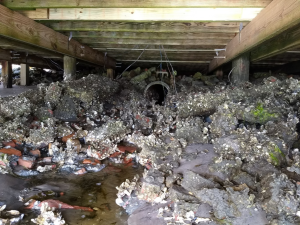New UNC-Chapel Hill study finds stormwater infrastructure inundation contributes to high tide flooding in coastal communities
June 3, 2022
Throughout human history, coastal residents have enjoyed the benefits of living near the ocean while balancing the associated risks. Coastal flooding, exacerbated by sea level rise, whether from the ocean, rivers, or rain is an ongoing challenge for many coastal communities. These communities rely heavily on stormwater infrastructures for flood mitigation, but these infrastructures have not been broadly assessed. A new study, led by researchers at the UNC Institute for the Environment, reveals that it may be time to reconsider the role these past innovations play in changing coastal systems.
A new study led by Adam Gold, a postdoctoral research associate at the Institute for the Environment, examines stormwater infrastructure inundation and the increase of urban flooding along the East Coast of the United States. The analysis, published in Earth’s Future, assessed the relationship between stormwater infrastructure inundation and high tide flooding in U.S. East Coast communities and found that it is a widespread problem affecting up to 2 million people.

“Even though you might not be seeing flooding on your roadway very frequently, it’s very likely that a lot of these coastal areas are having flooding, only underground. So let’s say you have a high tide flood that floods the road a couple of times a year. It’s very likely that the stormwater network underneath the road is being flooded maybe 20 to 30 times a year, so you’re having decreased capacity to drain from these areas,” said Gold.
High tide flooding, defined by the National Ocean Service as flooding that causes public inconvenience, has noticeably been exacerbated by climate-related sea level rise. The study analyzed over 100 census-defined urban areas along the East Coast. Through this research, Gold found that 130 of these urban areas had road areas impacted by high tide flooding.

For the 2 million coastal citizens who live in areas affected by high tide flooding, the causes may not be clear and obvious.
“I think awareness is key to understanding that this is a risk that is occurring nowadays, and our work shows that an engineering success from the past such as storm drain networks is now driving some of the flooding. We hope that our model will help communities address this risk by modifying infrastructure and looking for new solutions for this flooding,” said Gold.

The research team originally collected data in Beaufort, NC, then used those data to model the impacts of tidal water levels on storm drain networks. The modeling framework developed in this study provides a platform for both municipalities and researchers to identify vulnerable infrastructure and inform planning efforts to mitigate flooding.
“Nuisance flooding is a growing problem that has attracted significant recent attention,” said Michael Piehler, the director of the UNC Institute for the Environment and a professor at UNC-Chapel Hill. Piehler also served as a co-author of the paper. “I am so pleased for Adam to have produced this important foundational work with his co-authors from our lab. There have been presumptions that stormwater infrastructure plays a role in nuisance flooding, but we now have a robust analysis of the extent of the problem for the eastern U.S.”
